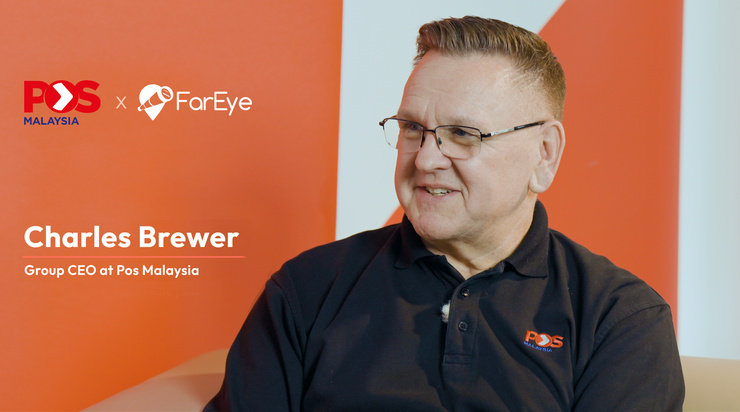- Logistics
Courier Delivery Management Software: Ways to Improve On-Time Delivery Rates
Table of Contents
- What Is a Courier Delivery Management System?
- Why On-Time Delivery Rates Matter More Than Ever
- Common Barriers to On-Time Delivery
- 5 Ways a Courier Delivery Management System Improves On-Time Delivery
- FarEye’s Capabilities as a Courier Delivery Management System
- How to Improve On-Time Delivery Rates Using FarEye
- Real-World Impact
- Key Features to Look for in a Courier Delivery Management Software
- Why Choose FarEye for Courier Delivery Management
- FAQs About Courier Delivery Management Systems

The growing consumer demand for same-day delivery services has created unprecedented pressure on logistics and supply-chain fleets.
Businesses must achieve speed and implement strategic ideas while maintaining measurable control over the entire delivery process to meet rising expectations. To achieve On-Time Delivery (OTD) rates, you must enhance planning capabilities.
The article explains how to track and enhance OTD metrics through practical delivery performance improvement strategies. It also identifies tools like courier delivery management software that support logistics teams to prevent delays and maintain customer satisfaction.
What Is a Courier Delivery Management System?
The courier delivery management system functions as a software-based solution that optimizes the complete logistics operations of parcel delivery. The systems enable businesses to automate essential delivery operations through their automated processes.
- Schedule shipments
- Assign orders to available couriers
- Monitor delivery status in real-time
- Use route optimization to get best outcomes based on traffic and location data
- Manage vehicle usage and fuel consumption
Evolution From Manual to AI-Powered Systems
The delivery of parcels and documents through human messengers who walked or rode horses formed the foundation of courier systems at their inception. Mechanized transportation during the late 19th and early 20th centuries brought about the transition of delivery services to trucks and vans, which dramatically improved delivery speed and reach.
During the early 2000s, companies began implementing delivery scheduling platforms in conjunction with GPS-enabled dispatch systems. CitySprint launched CityTrak in 2003 to handle bookings and courier assignments before implementing real-time GPS tracking for better customer visibility in 2009.
The AI-powered platforms of Veho, Dispatch, and Amazon enable route adjustments and dynamic disruption forecasting, as well as theft protection capabilities; these systems now power decision-making at scale.
Why On-Time Delivery Rates Matter More Than Ever
The success of businesses depends heavily on on-time delivery rates because these rates directly affect customer satisfaction, brand reputation, and business success. We’ll see how in detail:
Evolving Customer Expectations in B2C & B2B
The business risks in B2B operations remain elevated. Manufacturing operations and supply chain functions, as well as downstream revenue streams , suffer when shipments arrive late. 33% of consumers now expect faster shipping, and 93% want regular updates on their delivery status.
Delivery Delays and Their Business Impact
Business operations experience a chain reaction of adverse effects when delivery delays occur because they create customer frustration. Narvar data indicates that delayed deliveries result in a 1.1% increase in return rates for each day of delay.
The Cost of Missed SLAs and Lost Customer Loyalty
Companies that miss their Service Level Agreements (SLAs) experience revenue loss, face penalties, absorb return costs, and provide credits.
Research indicates that 32% of consumers will leave their favorite brands after their first negative encounter. The percentage of consumers who would switch to a competitor after experiencing two or three negative interactions reaches nearly 80%.
Common Barriers to On-Time Delivery
Here are the most common barriers to on-time delivery:
Traffic Congestion & Inefficient Routing
Congestion remains one of the biggest delivery challenges, especially in urban areas, where stop-and-go traffic, construction zones, and restricted delivery windows can disrupt entire schedules.
According to the American Transportation Research Institute, traffic congestion costs the U.S. trucking industry over $74 billion annually in lost productivity and fuel (truckingresearch.org).
Failed Delivery Attempts
A small yet significant percentage of last-mile deliveries fail on the first try, particularly in residential or gated locations. Each failed attempt increases costs through extra mileage, additional labor, and often requires manual follow-ups.
Lack of Real-Time Visibility & Communication Gaps
Manual processes increase the risk of human error and reduce scalability. In contrast, automated dispatch systems that consider location, traffic, delivery windows, and courier availability can improve on-time rates.
Manual Task Allocation & Dispatch Errors
When delivery assignments are made manually, through spreadsheets, texts, or disconnected tools, errors are inevitable. Couriers might be sent on overlapping routes, assigned jobs without considering proximity, or dispatched without full delivery details.
5 Ways a Courier Delivery Management System Improves On-Time Delivery
1. Real-Time Route Optimization
Traffic changes, road closures, and unexpected delays can throw off even the most carefully planned delivery schedules. A courier delivery management system dynamically adjusts routes based on real-time conditions.
2. Automated Courier Assignment & Scheduling
Manual courier allocation often leads to inefficiencies, such as overlapping routes or underutilized capacity. With delivery automation, the system instantly matches orders to the best-suited courier based on location, availability, and workload.
3. Live Tracking & Visibility for All Stakeholders
Courier delivery systems provide live tracking dashboards, driver locations, and estimated arrival times. This builds trust and reduces "Where’s my order?" calls, and enables more accurate planning across the board.
Want to know how FarEye improves on time delivery? Get a demo now
4. Exception Management & Delivery Issue Resolution
Delays and disruptions happen. But how quickly you respond makes all the difference. Courier management systems flag exceptions, such as failed delivery attempts or address issues, in real-time.
5. Performance Analytics & SLA Compliance Monitoring
A modern courier system tracks key performance indicators like on-time rates, delivery accuracy, and driver efficiency. Then it compares them to your service level commitments.
How Courier Delivery Use Cases Differ By Industry
Here's how they differ across retail, food delivery, and healthcare:
| Category | Retail | Food Delivery | Healthcare |
| Primary focus | Speed and customer experience | Speed and freshness | Security, compliance and time sensitivity |
| Common use cases | - eCommerce order delivery - Return pickups - Scheduled large-item delivery | - On-demand restaurant/grocery delivery - Multi-order batching | - Prescription delivery - Medical sample transport - Home healthcare kits |
FarEye’s Capabilities as a Courier Delivery Management System
Multi-Carrier & 3PL Integration Support
FarEye seamlessly connects with multiple carriers and third-party logistics (3PL) partners, allowing businesses to manage complex delivery networks from a single platform.
Customizable Delivery Workflows & Real-Time Alerts
Every business has unique delivery needs. FarEye enables you to configure workflows tailored to your operational model, like handling on-demand, same-day, or scheduled deliveries. Note that most implementations go live within 3 to 4 weeks.
Real-time alerts can be triggered at key points in the journey, such as dispatch, en route, delayed, or delivered.
Use Case: A grocery delivery service can set alerts for when perishables leave the warehouse, when they’re 10 minutes away, or if a delay threatens to break cold-chain compliance.
Predictive Analytics for Delay Avoidance
FarEye uses machine learning and real-time data (traffic, weather, and delivery density) to forecast potential delays before they happen. This enables rerouting or driver reassignment to minimize disruption.
Customer Communication via WhatsApp/SMS/Email
Keeping the customer informed reduces anxiety and support calls. FarEye enables proactive communication through the customer’s preferred channel, such as WhatsApp, SMS, or email, along with live tracking links and ETA updates.
Delivery Experience Management (DEM)
FarEye helps brands shape memorable delivery experiences. DEM features include branded tracking pages, post-delivery feedback collection, and coordination across touchpoints to ensure each delivery aligns with the brand’s promise.
Low-Code Configuration for Rapid Adaptation to Business Needs
FarEye’s low-code/no-code platform enables teams to adapt quickly, such as adding a new delivery flow, modifying workflows, or integrating with new partners.
How to Improve On-Time Delivery Rates Using FarEye
Here’s how to improve on-time delivery rates using FarEye:
Monitor Performance Metrics with a Unified Dashboard
FarEye consolidates carrier scans, GPS pings, and shipment milestones into a central control tower dashboard. This unified view provides dispatchers and managers with real-time visibility into delivery performance.
In one case, a global parcel carrier BlueDart saw a 22% increase in first‑attempt success after adopting FarEye tracking and dashboard visibility.
Use Historical Data to Forecast and Adjust Routes
FarEye’s predictive analytics model helps businesses forecast delays and optimize delivery windows. For instance, a leading household appliance manufacturer improved OTIF performance by 56% after using FarEye's route planning and demand forecasting capabilities.
Automate Courier Scheduling Based on Peak Delivery Hours
FarEye automates assignments based on capacity, geography, and order volume during peak demand periods. Our AI-powered scheduling dynamically allocates deliveries to the most efficient couriers. This led an African retailer to reduce delivery times by 15% while boosting NPS by 15 points, all as delivery volumes were scaling rapidly.
Enable Contactless & Efficient Handoffs
FarEye supports contactless handoffs with digital proof of delivery. This reduces manual errors and improves the speed and safety of each drop-off.
Real-Time Collaboration Between Drivers, Dispatch, and Customer Support
FarEye’s platform enables instant alerts and two-way communication between drivers, dispatchers, and support teams. Built-in exception management means that any delay or issue triggers automated notifications.
Real-World Impact
A premier American cabinet manufacturer improved its delivery success rate by 73%, raised OTIF performance by 16%, and saw Customer Satisfaction (NPS) climb by 34 points after adopting FarEye’s delivery orchestration and tracking solutions. Key improvements included enhanced route planning, dynamic scheduling, and automated exception handling.
Key Features to Look for in a Courier Delivery Management Software
Here are the key features to look for in a courier delivery management software:
Scalability and Integration Capabilities
Your delivery needs today might look very different six months from now, so flexibility is key. A good courier delivery management software should grow with you.
You might be expanding into new regions or working with multiple carriers; the system should integrate smoothly with your existing tools (such as your eCommerce platform, ERP, or TMS) and scale without requiring a rebuild every time your business shifts gears.
Mobile App for Couriers & Fleet Visibility
If your couriers are still juggling printed slips, texts, and manual check-ins, it’s time for an upgrade. A solid mobile app makes their day easier, as it lets them see their tasks, get optimized routes, collect proof of delivery, and stay in sync with dispatch.
On your end, you get a clear view of where everyone is, what’s on time, and where things might need a nudge from courier delivery management software.
Live Alerts for ETA Deviations
Delays happen, but surprises shouldn't. Real-time tracking alerts for missed ETAs let your team take action before customers start calling.
You might be rerouting a driver, sending out a quick update, or scheduling a fallback delivery, but you’ll have the tools to fix issues before they turn into complaints.
Heatmaps and Analytics for Zone-Based Delivery Optimization
Some areas always run smoothly, others? Not so much. Heatmaps and zone-based analytics help you identify patterns in delivery performance, such as regions with frequent delays or high reattempt rates.
That way, you can shift resources, refine routes, or rethink delivery time slots where it matters most.
Why Choose FarEye for Courier Delivery Management
FarEye positions itself as a logistics intelligence platform built for scale, speed, and customer satisfaction. Regardless of the industry you are in, FarEye brings together real-time visibility, intelligent automation, and rapid adaptability to help you deliver better results.
Future Trend: Moreover, AI is starting to take a front seat in how companies manage their drivers and delivery operations. As Forbes points out, it helps cut down the time spent on repetitive tasks and makes entire workflows more efficient. Businesses are now combining AI with tools they already use, like cloud-based delivery platforms that runs with less friction and smarter decisions.
Proven Results Across Retail, Q-Commerce & Courier Industries
From large retailers to last-mile logistics providers, FarEye has consistently improved on-time deliveries, reduced operational costs, and elevated delivery experiences. Its success across verticals shows its ability to adapt to high-volume, high-pressure delivery environments.
Fast Time-to-Value with No-Code/Low-Code Deployment
With no-code and low-code tools, your team can hit the ground running. It’s easy to customize workflows and adapt as your business grows, without waiting on a dev team to do it for you.
Predictive, Intelligent, and Customer-Centric Logistics Platform
FarEye utilizes predictive technology to help you identify issues before they become problems, such as traffic, missed ETAs, or failed deliveries. Plus, customers get proactive updates.
Explore how FarEye improves delivery KPIs, reduces delays, and enhances SLA compliance. Request a personalized demo today.
FAQs About Courier Delivery Management Systems
What is the best courier delivery management system for last-mile operations?
The best courier delivery management system is Fareye. The most effective delivery management systems include real-time tracking, route optimization, simple driver communication, and flexible scalability.
How does courier management software help reduce delays?
The courier management software utilizes real-time traffic data, delivery patterns, and historical trends to perform dynamic route adjustments.
Can I integrate my 3PL partners into a single courier dashboard?
The majority of contemporary courier systems include functionality to manage multiple carriers within a single network. You can integrate your 3PL partners to view all operations through a single dashboard.
How does FarEye ensure SLA compliance in real-time?
FarEye tracks every shipment milestone and delivery status as they happen. The system immediately alerts users when any delivery process deviates from the schedule.

Komal Puri is a seasoned professional in the logistics and supply chain industry. As the AVP of Marketing and a subject matter expert at FarEye, she has been instrumental in shaping the industry narrative for the past decade. Her expertise and insights have earned her numerous awards and recognition. Komal’s writings reflect her deep understanding of the industry, offering valuable insights and thought leadership.
Let's Talk to Our Experts and Optimize Your Deliveries Today!
An expert from our team will reach out within 24 hours
Related resources


